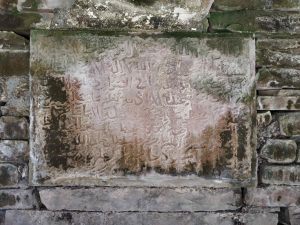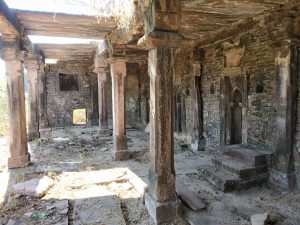IN03126 Eppāvaḷa Slab Inscription 2
The inscription is engraved on a stone slab. It starts on the front of the slab and continues onto the right side. The slab was found in Eppāvaḷa (Eppawala) in North-Central Province and subsequently transferred to the premises of the Archaeological Commissioner at Anuradhapura. The uninscribed portion of the slab contains a socket to fit into another stone, suggesting that, before it was utilised for the purpose of inscription, the slab served some architectural purpose. The first five lines of the inscription are badly preserved and a portion of the surface has been lost from the right side of the slab, obliterating about seven lines of writing. As the beginning of the inscription is not legible, it is not possible to make out the date but the text may be attributed on palaeographic grounds to the latter half of the tenth century A.D. It is concerned with the registration of an agreement entered into by the saṁgha of a certain monastery, stating that they would, at the end of the vassa season every year, supply gifts of rice, etc., to the brethren in return for some quantities of grains and other provisions placed at their disposal by one Mahin Agbohi.
OB03101 Eppāvaḷa Slab 1
IN03125 Eppāvaḷa Slab Inscription 1
The inscription is engraved on a broken guardstone found on the site of an ancient and overgrown vihara in Eppāvaḷa (Eppawala) in North-Central Province; the discovery was reported in the Archaeological Survey of Ceylon for the year 1890 and the guardstone was subsequently transferred to the premises of the Archaeological Commissioner at Anuradhapura. The lower part of the stone is missing but the inscription is complete except for the first two lines, which are too weathered to be read. Although the date of the inscription is no longer legible, the text may be attributed on palaeographic grounds to the latter half of the tenth century A.D. It is concerned with the registration of a gift to the image house and the Bō-tree at the Pamagalu Monastery by a person named Ukuṇuhusu Kottā. This was made by investing eight kaḷan̆das of gold in land and by depositing two kaḷan̆das so that the interest might be paid in paddy. Two more kaḷan̆das of gold were invested for the purpose of supplying curds and honey and for the maintenance of the canopy of the altar.
OB03090 Thūpārāma Slab of Gajabāhu I
IN03110 Thūpārāma Slab Inscription of Gajabāhu I
The inscription is engraved on a stone slab, which was discovered in October 1926 when the foundation of the western side of the enclosing wall of the Thūpārāma in Anuradhapura was cleared. The slab was set up vertically on the inner face of the foundation such that only about one foot (30.48 cm) of the slab would have been visible above the original ground level. The inscription is a grant issued by king Gajabāhu I (r. c. 113 – c.135 A.D.), who is referred to here by the name of Gamiṇi Abaya, as in many of his other inscriptions. The text tells us that the king granted certain incomes derived from the Goṇagiri-utaviya (a tank or a tract of paddy fields) to the monks of the Raṭaṇa Araba monastery. The royal grant ends after the fourteenth letter of the sixth line where traces of two short vertical strokes used as punctuation marks are seen. The rest of the record is in the nature of a postscript added later – but not far removed in time from the original grant, as there is no appreciable difference in the script – to the effect that the city accountant, whose name is not preserved, gave in exchange the water-revenue of the Nakaravavi tank (Nuwara Wewa).
Udaypur उदयपुर (Madhya Pradesh). Arabic and Persian inscription (INAP00005) in a mosque (OBAP00005) near Chatua Darwaza

Arabic and Persian inscription (INAP00005) in a mosque (OBAP00005) near Chatua Darwaza recording the construction of the building by Khān-i ʿĀlam Jangi Khān in the time of Islām Shāh; working reading of the text 02/2020.
Udaypur उदयपुर (Madhya Pradesh). Mosque near Chatua Darwaza with an Arabic and Persian inscription (INAP00005)
Udaypur, उदयपुर (Madhya Pradesh).

Mosque (OBAP00005) near Chatua Darwaza with an Arabic and Persian inscription (INAP00005) dated 1549 in the time of Islām Shāh of the Sūr dynasty.
OB03083 Poḷonnaruva Vēḷäikkāṟa Slab
Velaikkara Slab Inscription near the Atadage, Polonnaruwa
IN03103 Poḷonnaruva Slab Inscription of the Vēḷäikkāṟas
The inscription is incised on a fine granite slab found lying prone in the Tōpa-väva quadrangle (the Dalada Maluwa) in Polonnaruwa. The find was reported by H. C. P. Bell in his Annual Report of the Ceylon Archaeological Survey for 1903 (p. 11). The slab was subsequently framed with cement and placed upright near the Atadage in the Tōpa-väva quadrangle, where it stands today. Consisting of forty-nine lines in total, the inscription is written in Tamil with an introductory Sanskrit verse. It was erected by the members of the Vēḷäikkāṟa (or Velaikkara) community. As part of the expeditionary forces of Rājēndra Coḷa I, the Velaikkaras established themselves as a powerful force in northern Sri Lankan following the capture of Mahinda V in 1017–18 A.D. They were subjugated by king Vijaya-Bāhu I in 1073 A.D. but rebelled against his authority eleven years later, after he asked them to fight in his military campaign against their own kinsmen, the Coḷas. Although the king’s forces quickly quelled the rebellion, the Velaikkara community continued to hold considerable power. Indeed, such was their influence that, during the turbulent period of internal conflict that followed Vijaya-Bāhu I’s death, they were entrusted with the protection of the Sacred Tooth-relic Temple, which had been built (probably some twenty or thirty years earlier) by the minister Deva Senāpati under Vijaya-Bāhu’s orders. This inscription was erected around this time to provide written assurance that the Velaikkara soldiers would protect the sacred relics. The first part of the text serves as an introduction, describing Vijaya-Bāhu I’s charitable acts, including the building of the Tooth-relic temple. The second part details the provisions made by the Velaikkaras for the protection of the temple and relics. No date is given in the text but, drawing on a combination of palaeographic and historical evidence, Wickremasinghe argues that it dates from between 1137 and 1153 A.D., belonging either to the reign of Vikkama-Bāhu (1116–1137 A.D.) or, more probably, to that of his son Gaja-Bāhu (1137–1153 A.D.).

